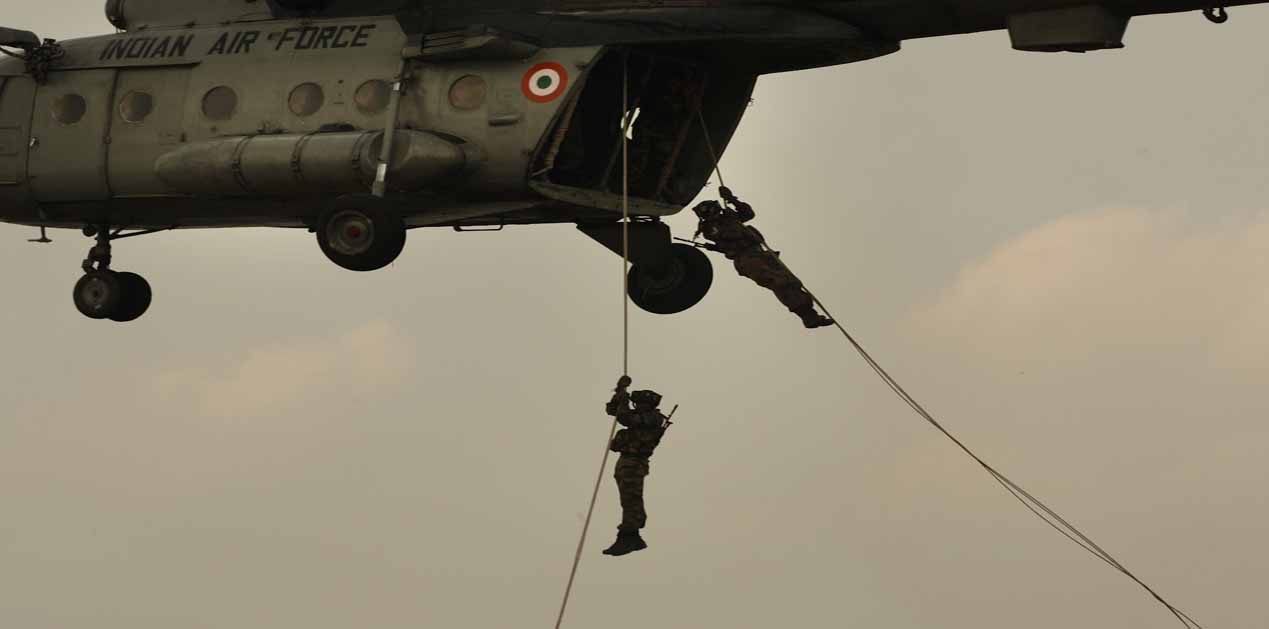Thucydides said, “Peace is a temporary truce in a war that is continuously going on.” India is at war since 1947 as no nation has fought so many conventional and sub-conventional conflicts post World War–II as India. Incidentally, each of these wars were different from others. Wars that were imposed on India were conventional wars (1962, 1965 & 1971), local war (Kargil), proxy war (Jammu & Kashmir, or J&K) and sub-conventional conflicts (insurgency in the North East and Left Wing Extremism, or LWE). Being a young nation, the Indian politico-military leadership had little knowledge of science and art of war fighting, and that was acknowledged by Nehru post-1962 debacle when he said, “We made a mistake by not building military capabilities.”1 Building capability is a military science and employment of that capability is an art inherent to military leadership. Therefore, political and military leadership should be in sync with each other to identify what capabilities are required and how that capability should be leveraged to achieve national security objectives.
When the first Commander-in-Chief of the Indian Army, General Sir Rob Lockhart, went to Nehru with a formal defence paper that needed a policy directive from the Prime Minister, Nehru had exclaimed, “We don’t need a defense policy. Our policy is ahimsa (non-violence). We foresee no military threats.”2 Nehru was convinced that India faced no threat and even if it existed it could be dealt with diplomatically and by the principles of Panchsheel. But the myth was exposed when India was forced to fight the first war in 1947-48 itself and then three conventional wars in a period of one decade (1962 to 1971). Nehru had refused to lay down a defence policy for his passive notions but for some unknown reasons even the successive political leadership of the country refrained from spelling out a defense policy or a National Security Strategy (NSS). As a consequence, formulation of military strategy has dithered and a military doctrine continues to remain a distant reality. Whereas ratification of both these documents by the National Security Council (NSC), to build military capabilities and to guide military actions during peace and war, are essential, in the absence of these principle government policy documents, the big question remains, ‘defence preparedness and capability building - for what’?
It is beyond comprehension that in spite of the number of wars India has fought and military crisis it has faced in the last seven decades, India has not put in place a functional Higher Defence Organisation (HDO) that can deal with issues of national security in a structured manner. Thus voids exist in policy formations related to national security, capability building, defence reforms, defence planning process and robust border defence.
Credible military capabilities dictates the military actions against a given security problem. Temptation to play with luck in the matters of national security is a dangerous policy. A nation must take military recourse against a security threat, firstly, after other options are exhausted, and secondly, when it is sure that it is in a position to build up the response with speed and sustain it even if the conflict escalates to a theatre or full-spectrum war. Rushing military as first respondent when there are border defence forces in place is an unwise strategy and suggest lack of understanding of principles of war and capability building; once military is deployed, taking a step back is seen as strategic surrender, but pulling back border defence forces is not seen with the same prism.
National security needs a structured and professional approach and cannot be left to the bureaucracy at the Ministry of Defence (MOD) and part time political heads. Major fault lines that exist in the national security system are:-
• HDO and its components are in place but the functioning is adhoc with no clear agenda to deliberate and periodically review the defence preparedness and capability building. NSS and Strategic Defence and Security Review (SDSR) are basic documents that would determine as to what capabilities are required in the near or distant future. In the absence of such systematic approach, the nation has not been able to build basic threshold capabilities to deal with the local wars in the immediate near future, theatre wars in next two to five years and full spectrum wars in next 10 years.
• There is no military advisor integral to Prime Minister’s Office (PMO), NSC, and even National Security Council Secretariat (NSCS). As a result the decisions on defence related issues are taken through inputs received from MOD which at times may not be in consonance with the Services Headquarters. As a result Cabinet Committee on Security (CCS) and NSC both are deprived of vital professional inputs and assessment on defence preparedness. Risk assessment on vital national security issues is conspicuous by its absence. Acquisition of weapon systems and equipment has become a tool for diplomatic engagement and that is not a good idea to build capabilities. Acquisition of 36 Rafale fighter aircrafts and weapons and equipment acquisition of approximately $10 Billion from Russia is an example of this policy.
• India has handled short term threats and crisis reasonably well. What has been the biggest problem is the capability building to deal with long term threats. The NSC has fallen short of expectations to identify the capabilities required for building threat cum capability based force for predictable and unpredictable external and internal threats.
• National security is one of the most vital function of the government. It needs political direction, professional inputs and a regular reviews. Whereas in the Indian context it is left to the military to manage with whatever budget is left over from the other priorities of the government to meet the external and internal challenges. Gen VP Malik’s statement during Kargil war that “We will fight with whatever we have” is a sorry state of affairs that exist in the system even today. The French Chief of Armed Forces resigned over defence budget stating, "In the current circumstances I see myself as no longer able to guarantee the robust defense force I believe is necessary to guarantee the protection of France and the French people, today and tomorrow and to sustain the aims of our country."3 It is not necessary for a chief to resign but professional integrity does call for transparent and frank audit of military capabilities and what the armed forces can do within the budget constraint. The political leadership and nation should know about the capabilities so that nation does not live on a false hope.
• Border defence is split between Ministry of Home Affairs (MHA) and MOD. Border management forces look at borders from police perspective whereas Line of Actual Control (LAC) and Line of Control (LoC) require military approach given the sensitive nature of the unresolved border disputes. Border management forces should ideally be equipped and trained for defending the borders during war because primary objective of deployment of these forces along LAC/ LoC is to seize initiative from adversary if situation so warrant. Since the hierarchy of border management forces is from police, therefore the troops are neither equipped nor trained to undertake proactive actions to position itself in an advantageous position for subsequent offensive or defensive operations during hot war scenario. A mindset of peacetime responsibility is a dangerous outlook. Another glaring fault in border defence is that the command of the border management forces will be shifted from police to Army at most critical period when transition from peace to war takes place. Whereas the command of troops during transition from peace to war should be stable so that it does not create turbulence. But in the current system turbulence is inherent and there is uncertainty because troops will be under the command of those military leaders with whom they have neither trained nor established a bond of comrades in arm. As a matter of principle, changing the horse in mid-stream is against the principles of war. The fault does not lie with CAPF or its leadership but the fault lies with the political system that has brought this turbulence in the system due to lack of understanding of national security.
• Ministry of External Affairs (MEA) and military should be in sync with the emerging threats to national security. The current interaction is cosmetic in nature and except occasional briefings by operational directorates, exchange of views and intimate interaction is minimal. Whereas diplomats serving in missions abroad should have intimate knowledge about the ground situation and existing military capabilities, or else how can they leverage national power to protect vital national interests. Whether one is uniformed or in civvies, greater understanding can only come when one physically interacts with the geography, and those who defend these geographical boundaries.
Way Forward
There is a need to understand that wars are political in nature and politico-military leadership matters in preservation of national interests because ultimately that makes the difference in outcome of a war.4 Thus there is a need to have intimate relationship between military and political leadership. This relationship cannot be indirect because military ultimately is employed by political leadership to achieve political objectives. No army can achieve political objectives without requisite military capabilities hence there is a need for a functional HDO that can assist political leadership to build military capabilities to serve the interest of the nation. The U.S. military had been completely refurbished after the debacle of Vietnam War5 because political leadership realised that the existing structures and capabilities were inadequate to serve US interests any longer. Defence Reforms and restructuring of HDO in Indian context is long overdue. India should learn lessons from modernisation of PLA, Syrian War and Hezbollah-Israel war. Lessons from Syrian crisis is that one should deal with the problem of war when war isn't imminent. 6
The way forward to bridge the fault lines are as under:-
• HDO is an apex body responsible for the security of the nation and to guide the national security strategy. It can minimise the danger of misjudgment, miscalculation, escalation and unintended consequences in modern warfare.7 Review of HDO is paramount, it requires restructuring so that decision time is reduced and the inputs received through decision support system are pragmatic and plausible. Such input can only come when HDO has professional representatives at NSC, PMO and NSCS level. There is a requirement of HDO and its components to meet regularly to preview the agenda of national security. If there is periodic review of defence preparedness by HDO, then India would not be in a state when ammunitions stocks fall dangerously8against the Minimum Acceptable Risk Level (MARL).
• SDSR must be carried out once in every five years and NSC should review it annually to carryout course corrections in defence planning process and prioritisation of capability building. SDSR will set the stage for capability building and draw attention of the political leadership at risks and opportunities in near future. SDSR will guide defence planning process, capability building, military strategy and doctrine. Indeed, SDSR is one of the primary charter of NSCS and one of the most important document to guide the future strategies in matters related to national security.
• There should be a system of debate on risk assessment before adoption of a strategy that has impact on national security. It must lay down military, political and diplomatic impact before a major military posturing or manoeuvre is undertaken. Situation such as in 1962, and to some extent in Sri Lanka, can be avoided if such a system under NSCS exist; else decision taken in a state of excited political mind are likely to cause serious reversals and could compromise national security.
• There is a need for deeper coordination between MEA and Services Headquarters. Indication of development of capabilities required for future challenges should come from the diplomats deployed in missions abroad. Inputs from the MEA along with that of the external intelligence agencies should be validated by the Services and projected to the NSC.
• Fragmented approach and divided command of border defence is an artificially created fault line. Current system of border management of unsettled borders is flawed that needs to be junked and the capabilities should be upgraded to border defence; there should be unity of command and homogeneity in training, equipment and ethos.
Prevailing international security scenario is extremely complex and vulnerabilities to the national security is no more restricted to geographical proximity nor purely military in nature. Contemporary and future wars are unrestricted in space, duration, resources and tools. Preparation for war under such scenario is the responsibility of political leadership because they have to dictate as to what capabilities are required to meet national security objectives. There is no harm in admitting that India has failed to keep pace with the security challenges it is likely to face in near future. The reasons could be political, economic or diplomatic, but one of the prime reasons is lack of strategic and military understanding by the political leadership. This has further been compounded by the fact that bureaucracy has insulated the political leadership which too has avoided facing tough questions on national security issues.
The Doklam standoff should act as reminder to the nation that it is more important for the political leadership to directly interact with military in peace time to understand the nuances of capability building and war fighting. This assumes significance because future wars are going to be complex, lethal and damages will be irreversible. Perforce, there is a need to incorporate professionals in planning, policy making and audit of capabilities.
Conclusion
The current Doklam stand-off is an opportunity to integrate political and military leadership and to set a foundation for structured response to crises in future. If a nation desires that it must retain ability to dominate and control situations, it must develop capabilities that give it strength to negotiate, from not under fear or coercion, but from position of strength. JF Kennedy said that “Never negotiate from fear and never fear to negotiate”.9 It is opined that the CCS has handled short term threats reasonably well but the biggest problem lies in capability building. That is the charter of NSC - to oversee the defence planning process and support it with dedicated budgetary support.
If a local war with China is just one stand-off away and limited war with Pakistan is just one terror strike away, in that case it is vital for India to focus on development of military capabilities in an earnest manner, without further delay and political passivity.
(Brig Narender Kumar, SM, VSM, is a Senior Fellow at the Centre for Land Warfare Studies)
Endnotes
1. Nehru and the Indian Armed Forces 5th Lecture - by General J N Chaudhuri, 5th May 1973. Accessed from https://www.cambridgetrust.org/assets/documents/Lecture_5.pdf on March 19, 2017.
2. How Nehru, Menon conspired against army chief Thimayya, Hindustan Times, Feb 13, 2016
3. Simon Carraud and Michel Rose, France's armed forces chief resigns after clash with Macron over budget cuts, Reuters World News, July 19, 2017
4. James Jay Carafano, 5 Big Lessons from the First Gulf War, The national Interest, August 10, 2015.
5. Ibid
6. Ronald Glossop, What Lessons Should We Learn from the Crisis in Syria? Citizens for Global Solutions, August 30, 2013.
7. Mark Thompson, 50 Years Later: The Lessons of the Cuban Missile Crisis, Accessed on July 22,2017from http://nation.time.com/2012/10/22/50-years-later-the-lessons-of-the-cuban-missile-crisis/, Oct. 22, 2012
8. Shaurya Karanbir Gurung, No improvement in Army's availability of ammunition: CAG, The Economic Times, July 22, 2017.
9. Mark Thompson, 50 Years Later: The Lessons of the Cuban Missile Crisis, Accessed on July 22,2017from http://nation.time.com/2012/10/22/50-years-later-the-lessons-of-the-cuban-missile-crisis/, Oct. 22, 2012
Image Source: http://4.bp.blogspot.com/-5jK6SufBEqY/T09nsfshZ5I/AAAAAAAABws/HnFpITbrWeY/s1600/ROKA7642.jpg











Post new comment